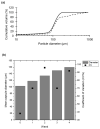Microencapsulation of Bacteriophages Using Membrane Emulsification in Different pH-Triggered Controlled Release Formulations for Oral Administration
- PMID: 34063218
- PMCID: PMC8147480
- DOI: 10.3390/ph14050424
Microencapsulation of Bacteriophages Using Membrane Emulsification in Different pH-Triggered Controlled Release Formulations for Oral Administration
Abstract
An E.coli-specific phage was encapsulated in three different pH responsive polymer formulations using the process of membrane emulsification. Small 100 µm capsules were fabricated and shown to afford phages suitable acid protection upon exposure to pH 1.5. Selection of polymer formulations allowed controlled release of phages at pH 5.5, pH 6 and pH 7. Other aspects of phage encapsulation including factors affecting encapsulation yield, release kinetics, acid and storage stability were evaluated. The work presented here would be useful for future evaluation of new therapeutic strategies including microbiome editing approaches allowing pH-triggered release of phages and delivery of encapsulated cargo to different intestinal compartments. The size of the capsules were selected to permit ease of delivery using small bore oral gavage tubes typically used in pre-clinical studies for evaluation of drug substances using small animal vertebrate models such as in mice and rats.
Keywords: antibiotic resistance; bacteriophages; drug delivery; membrane emulsification; microbiome engineering; microcapsules.
Conflict of interest statement
The authors declare no conflict of interest.
Figures









Similar articles
-
Bacteriophage Encapsulation in pH-Responsive Core-Shell Capsules as an Animal Feed Additive.Viruses. 2021 Jun 11;13(6):1131. doi: 10.3390/v13061131. Viruses. 2021. PMID: 34208387 Free PMC article.
-
Microencapsulation of Enteric Bacteriophages in a pH-Responsive Solid Oral Dosage Formulation Using a Scalable Membrane Emulsification Process.Pharmaceutics. 2019 Sep 14;11(9):475. doi: 10.3390/pharmaceutics11090475. Pharmaceutics. 2019. PMID: 31540028 Free PMC article.
-
Microencapsulation of Clostridium difficile specific bacteriophages using microfluidic glass capillary devices for colon delivery using pH triggered release.PLoS One. 2017 Oct 12;12(10):e0186239. doi: 10.1371/journal.pone.0186239. eCollection 2017. PLoS One. 2017. PMID: 29023522 Free PMC article.
-
Microencapsulation of protein drugs for drug delivery: strategy, preparation, and applications.J Control Release. 2014 Nov 10;193:324-40. doi: 10.1016/j.jconrel.2014.09.003. Epub 2014 Sep 10. J Control Release. 2014. PMID: 25218676 Review.
-
Formulation, stabilisation and encapsulation of bacteriophage for phage therapy.Adv Colloid Interface Sci. 2017 Nov;249:100-133. doi: 10.1016/j.cis.2017.05.014. Epub 2017 May 14. Adv Colloid Interface Sci. 2017. PMID: 28688779 Review.
Cited by
-
Bacteriophage Encapsulation in pH-Responsive Core-Shell Capsules as an Animal Feed Additive.Viruses. 2021 Jun 11;13(6):1131. doi: 10.3390/v13061131. Viruses. 2021. PMID: 34208387 Free PMC article.
-
Manufacturing Bacteriophages (Part 1 of 2): Cell Line Development, Upstream, and Downstream Considerations.Pharmaceuticals (Basel). 2021 Sep 17;14(9):934. doi: 10.3390/ph14090934. Pharmaceuticals (Basel). 2021. PMID: 34577634 Free PMC article. Review.
-
Enhancing phage therapy by coating single bacteriophage-infected bacteria with polymer to preserve phage vitality.Nat Biomed Eng. 2025 Jul;9(7):1155-1171. doi: 10.1038/s41551-025-01354-3. Epub 2025 Feb 25. Nat Biomed Eng. 2025. PMID: 40000896
-
Phage Delivery Strategies for Biocontrolling Human, Animal, and Plant Bacterial Infections: State of the Art.Pharmaceutics. 2024 Mar 8;16(3):374. doi: 10.3390/pharmaceutics16030374. Pharmaceutics. 2024. PMID: 38543268 Free PMC article. Review.
-
Phage lysins for intestinal microbiome modulation: current challenges and enabling techniques.Gut Microbes. 2024 Jan-Dec;16(1):2387144. doi: 10.1080/19490976.2024.2387144. Epub 2024 Aug 6. Gut Microbes. 2024. PMID: 39106212 Free PMC article. Review.
References
-
- Khan M.A. Detection of Colonized Pathogenic Bacteria from Food Handlers in Saudi Arabia. J. Pure Appl. Microbiol. 2018;12:1301–1306. doi: 10.22207/JPAM.12.3.32. - DOI
-
- Amenu D. Antimicrobial Resistance for Enteric Pathogens Isolated from Acute Gastroenteritis Patients. World J. Nat. Appl. Sci. 2014;1:1–14.
-
- Begum Y.A., Talukder K.A., Azmi I.J., Shahnaij M., Sheikh A., Sharmin S., Svennerholm A.-M., Qadri F. Resistance Pattern and Molecular Characterization of Enterotoxigenic Escherichia coli (ETEC) Strains Isolated in Bangladesh. PLoS ONE. 2016;11:e0157415. doi: 10.1371/journal.pone.0157415. - DOI - PMC - PubMed
Grants and funding
LinkOut - more resources
Full Text Sources

